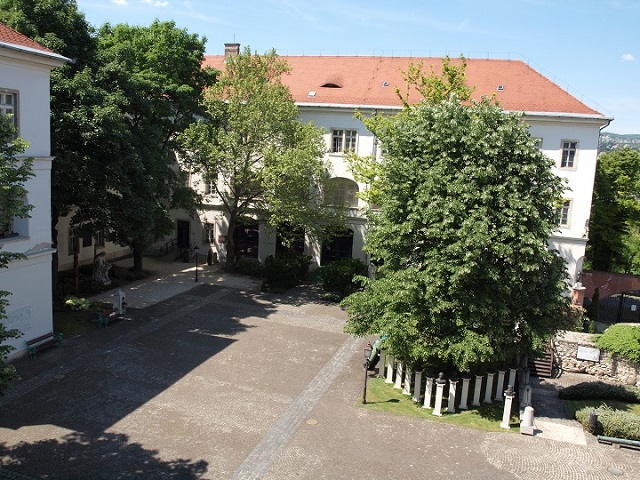Following the relocation of the military technology park, the courtyard of the institute transformed from an exhibition area to a memorial park, appropriate for housing celebrations, in 2002. After the Democratic Transformation in Hungary, in the early 1990s, seeds from trees from sites of Hungarian military historical importance like Verecke Pass, the Doberdo Heights, the Don Bend, Kéménd (today Kamenín, Slovakia) in historic Upper Hungary and Torda (today Turda, Romania) in Transylvania were planted and grown into pines of considerable size in the cultivated garden as reminders of former battlefields. Among the several memorial plaques on the inner frontage are some finely restored pieces which decorated the walls even before the Second World War, but were later removed due to ideological reasons.

The inner courtyard of the Institution
The memorials on the wall of the Museum wing facing the courtyard include the plaque of the Imperial and Royal 82nd Infantry Regiment (re-erected in 2004), presently situated between the bronze relief portraying the “storming” hussars of the 1914 Gorodok cavalry charge (by György Nemes, re-erected in 2004), and the large memorial immortalizing the Royal Hungarian 15th (Trencsén [today Trenčín, Slovakia]) Infantry Regiment’s engagements through a map and ornamented by the coats-of-arms of the counties from which the soldiers of the unit had been recruited (re-erected in 1997).
Next to the entrance from Kapisztrán Square two bronze busts commemorate two significant figures of the Institution’s past: Royal Hungarian Colonel Kamil Aggházy (1882–1954), founder of the Military History Museum, and Royal Hungarian Colonel (Brevet General) János Gabányi (1871–1934), founder of the Military History Archives (by Zsolt Gulácsy-Horváth, 2002–2003).
The most spectacular and earliest monuments are the remains of the castle wall and horseshoe tower built in defence of the civilian town of Buda after the Mongol invasion of Hungary in the 13th century, which was discovered during the archaeological excavations in 1987–1988. The “candle lighting on All Souls’ Day” has become a vital part of state military protocol, on 1 November candles are lit at each memorial in remembrance of the fallen – many at the plaque remembering those who fell or went missing at the Don Bend and at the prisoner of war memorial (“Shivering Soldier”, erected by the Comradely Association of Former Prisoners of War in 1997). The symbolic grave of the Unknown Soldier was made appropriately near the remains of the mediaeval tower, where the central candle lighting takes place.
Certainly, artillery pieces that are less sensitive to weather (gun barrels, mostly from the 18th century) are displayed, among which perhaps the most interesting piece is the considerable sized bronze Ottoman cannon barrel weighing 3600kg, nicknamed “Long Hassan”, which was cast in Buda and most probably took part in the fights in the autumn of 1686, when the castle and the town was liberated from the 145-year-long Ottoman occupation. The piece was discovered next to the Museum at the Esztergom Roundel in 1935, during the groundworks of General Artúr Görgei’s equestrian statue. But one can also examine, among others, a M1914/35 10cm howitzer.
One of the remaining side figures of the highly controversial former Hentzi monument, The Martyrdom, which commemorated the Austrian defender of Buda Castle during the Hungarian War of Independence in 1849, stands on an upstairs pillar of the north-eastern part of the courtyard.
In the rear section of the courtyard, behind the castle wall one can also find more modern military memorials. A reconstructed fortified machine-gun position from the fortress line established along the Yugoslavian border in the 1950s is considered a unique piece. It incorporates the turret of a Second World War German Pz IV tank which had been part of the original establishment. At the same place visitors can witness (now safely) a section of the “Iron Curtain”, the border defences established along Hungary’s western frontiers during the Cold War period.



